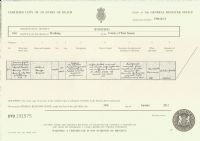ARTHUR GEORGE CRAME
SOLDIER DEAD IN POOL OF BLOOD AT BILLET
The story of a soldier who was found lying dead in a pool of blood in his room with a rifle besides him was told at the at Worthing Town Hall on Monday. He was Sapper Arthur George Crame, whose age was estimated at 33, and he was stated to have been a postal worker, of Newbury.
It was revealed that he had been in the Army between two and three months. He was described as of a quiet and reserved disposition and a good worker. No light was thrown on what had led to his death.
Lieutenant Arthur Pearce said he was a member of a court of inquiry held on Friday relating to the death of Crame. He produced a copy of the proceedings.
SAPPER'S DISCOVERY.
Corporal Frederick Diggins said he on provost duty in the police room at about 10.10 p.m on Thursday. A sapper entered to report his return from leave. Then he left, and returning a few minutes later, informed witness that there was a man dead in his room.
"I went with him” continued witness, "and saw a sapper lying face downwards in a pool of blood.”
The Coroner (Mr. F. W. Butler): Was he clothed ?—Witness: Partially clothed, with slippers on. I touched the body and found it cold and stiff.
Is it a fact there was a rifle lying by his side?—Yes.
Which way was It pointing?—Towards the head.
Did you know the man?—Yes.
As Arthur George Crame?—Yes, commonly called " Bob.”
Had he been occupying that room with others?—Prior to the men being sent on leave, he had.
How long had he been alone?—About three days.
He added that he did not hear a report of a rifle.
MEDICAL EVIDENCE.
Captain John Clive Baird Nesfield, R.A.M.C., said that at about 10.30 on Thursday night he received a telephone message from the Adjutant asking him to go to the scene at once as he believed there had been an attempted suicide. Witness arrived at the room at 10.40 p.m., and was directed to a room on the top floor. The corporal told him the sapper appeared to be dead. The civil police and two members of the military police were already in the room.
The body, which was in a pool of blood, was dressed in shirt, trousers, and "gym." shoes. There was a rifle close to the left side. Rigor mortis was fully established.
In witness's opinion, the man had been dead at least four hours. Witness rolled the body over, and saw a wound in the front of the chest, and about three pints of blood had been spilt on the floor.
Witness produced an empty cartridge case and the Coroner asked if there were any more. Witness: No, sir. Lying on the bed was a bullet case bandolier, in which were 19 rounds of ammunition. In one of the clips one case was missing.
Witness went on to say he made a post mortem examination the following day and thought the deceased was about 33 years old. There were no external signs of corrosive poisoning. The left lung had collapsed and disintegrated.
In his opinion death was due to a missile having penetrated the chest and lung substance.
UNFINISHED LETTER
"A wound of this nature," added witness, "would cause such profuse haemorrhage that death would be instantaneous."
The Coroner: Do you know that he belonged to Newbury, and was a postman there ?—Witness : I knew he came from Newbury.
Witness mentioned that be found a letter which had only just been started, and another letter In the deceased's klt-bag.
The Coroner : Are you in a position to express an opinion as to whether the wound was self-Inflicted? Witness: Judging from the position of it, it rather suggests it was.
Referring to the letter found in deceased's kit-bag, witness said he was unable to say whether it was in the man's hand -writing.
The Coroner Prima facie, one might assume it was his writing.
Lieutenant Pearce told the Coroner the deceased was looked upon as a good worker. He joined up two-and-a-half to three months ago. There had been no trouble in the unit.
The Coroner returned a verdict that deceased died from a rifle bullet wound In the chest, self-inflicted, but there was not sufficient evidence to show the state of his mind at the time.
Major F. W. Heath, M.C.,R.E.,expressed the sympathy of the unit with the bereaved family, and the Coroner identified himself with these observations.
|




